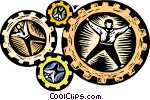In a recent Forbes article, HR Managers were advised to focus on “talent management.” Sounds reasonable given the information age, internet and the competitive need for creativity, but I find myself asking, “Who wants to be treated as talent to be managed?”
It reminds me of factory workers in the early 1900’s who were seen as extensions of the machine to be optimized.  Although the world has changed, articles like Forbe’s suggest we are still seeing employees as “cogs in the organizational machinery,” talented cogs to be sure, but cogs. And therein lies a problem.
Although the world has changed, articles like Forbe’s suggest we are still seeing employees as “cogs in the organizational machinery,” talented cogs to be sure, but cogs. And therein lies a problem.
As long as HR Managers (and senior Leaders) see people as company assets to be optimized, we’ll continue to create environments that kill the human spirit. Employees will remain disposable parts, abstract concepts to be planned for, controlled and manipulated. CEOs and organizational hierarchy will continue to see themselves separate from the “masses.”
But different models are emerging, each the result of the beliefs, personal passion. and unique circumstances of their creators. In each example people are, well people, not assets. 
Here are some of my favorite out-of-the-box examples: Ricardo Semler’s Maverick: The Success Story Behind the World’s Most Unusual Workplace, Tony Hsieh’s story of Zappo’s Delivering Happiness: A Path to Profits, Passion, and Purpose
, Phil Jackson and Hugh Delehanty’s Sacred Hoops: Spiritual Lessons of a Hardwood Warrior
, and Jack Stack’s The Great Game of Business, Expanded and Updated: The Only Sensible Way to Run a Company
.